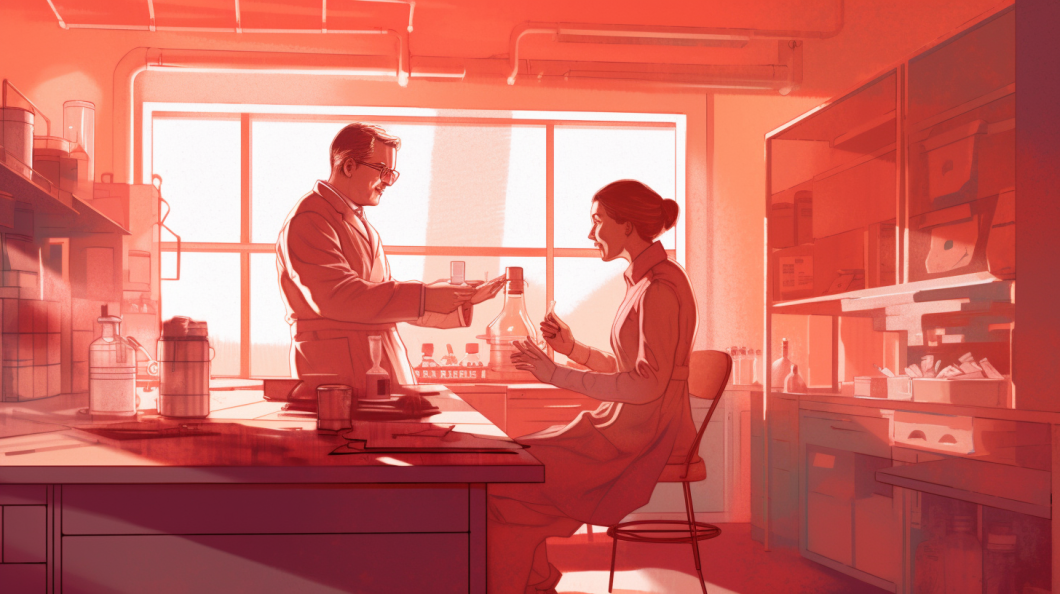Welcome to our in-depth guide on becoming a phlebotomist—a career that is as essential as it is rewarding in the healthcare field. Have you ever visited a clinic or hospital and had your blood taken for tests? The professional responsible for this procedure, called phlebotomy, is a phlebotomist. They play a crucial role in helping doctors diagnose and treat illnesses.
If you’re fascinated by the medical field, enjoy helping others, and are not daunted by the sight of blood and needles, a career in phlebotomy might be just the right path for you. In this comprehensive blog post, we’ll delve into the nitty-gritty details of how you can become a phlebotomist.
We’ll cover everything from an overview of the role of a phlebotomist, the educational requirements, the steps you need to follow to become a certified professional, the necessary skills and qualities for success in this career, and finally, we’ll take a look at the career outlook and potential advancement opportunities in phlebotomy. Let’s embark on this journey and explore the rewarding career of a phlebotomist.
The Role of a Phlebotomist
Phlebotomists are healthcare professionals responsible for accurately drawing blood from patients for medical testing, donations, or research. They may work in various healthcare settings, including hospitals, diagnostic laboratories, blood donation centers, and doctors’ offices.
Phlebotomists are often the face of the laboratory, interacting directly with patients. They play a pivotal role in the patient’s experience as they need to ensure that patients feel comfortable during the blood draw process.
Besides drawing blood, their job description also includes properly identifying patients, explaining the procedure to patients, ensuring the safe handling and labeling of blood samples, and updating patient records.
Although the primary role of a phlebotomist revolves around blood collection, their responsibilities may extend to taking vital signs, preparing specimens for laboratory analysis, maintaining medical equipment, and managing patient data.
Moreover, phlebotomists need to adhere to strict safety and hygiene protocols to protect themselves and their patients from infectious diseases.
To become a proficient phlebotomist, you need to develop a set of key skills, which we will discuss later in this blog. However, the foundation rests on precision, patience, and excellent interpersonal skills, as a substantial part of the job involves reassuring nervous patients and providing clear communication.
In the following sections, we’ll discuss the path to becoming a phlebotomist in more detail, starting with the educational requirements for this career.
Educational Requirements
 To embark on a career as a phlebotomist, you’ll first need to meet some basic educational requirements. These are essential stepping stones that equip you with the knowledge and skills necessary to carry out the duties of a phlebotomist.
To embark on a career as a phlebotomist, you’ll first need to meet some basic educational requirements. These are essential stepping stones that equip you with the knowledge and skills necessary to carry out the duties of a phlebotomist.
- High School Education: A high school diploma or a General Education Development (GED) certificate is the basic requirement. Taking science subjects such as biology and chemistry can be beneficial as they provide a foundation for the medical knowledge you’ll need later on.
- Post-Secondary Education: After high school, you’ll need to enroll in a phlebotomy training program. These programs are offered at community colleges, vocational schools, and some hospitals. A typical program lasts anywhere from a few weeks to several months, and it provides both classroom instruction and practical training. You’ll learn about human anatomy, particularly the circulatory system, safe handling and disposal of blood samples, legal and ethical aspects of patient care, and hands-on phlebotomy techniques.
The successful completion of the training program often requires a specific number of successful blood draws and the demonstration of competency in various phlebotomy procedures. Once you have completed your training, you will be eligible to sit for a certification exam.
In the next section, we’ll walk you through the process of becoming a certified phlebotomist, step by step.
Steps to Becoming a Phlebotomist
Becoming a phlebotomist involves several steps that lead you from your basic education to the professional world of healthcare. Let’s walk through these steps one by one:
- Graduate from High School or Get a GED: The first step to becoming a phlebotomist is to complete your high school education or obtain a GED. Classes in biology, chemistry, and health can provide a good foundation for your future studies and career.
- Enroll in a Phlebotomy Program: Once you’ve graduated from high school, the next step is to enroll in a phlebotomy training program. This program will provide you with the knowledge and practical skills you need to become a phlebotomist. You’ll learn about topics such as human anatomy and physiology, the proper techniques for drawing blood, and the legal and ethical considerations of patient care.
- Complete Clinical Hours or Externship: Most phlebotomy programs include a practical component, where you’ll gain hands-on experience in a clinical setting. This may involve a certain number of hours or procedures that you must complete under supervision.
- Pass a Certification Exam: While not always required, obtaining a certification can improve your job prospects and show potential employers that you have met a certain standard of proficiency. There are several organizations that offer certification exams, and we’ll cover this in more detail in the next section.
- Apply for Jobs and Start Working: Once you’ve obtained your certification, you’re ready to start applying for jobs as a phlebotomist. You might find employment in a variety of settings, from hospitals and clinics to blood donation centers and medical laboratories.
Becoming a phlebotomist requires a mix of formal education, hands-on training, and dedication. In the next section, we’ll delve deeper into the importance of certification and how to prepare for it.
Detailed Look at Phlebotomy Certification
While certification might not always be required, it is highly recommended for aspiring phlebotomists. Being certified not only increases your chances of getting a job but also boosts your professional credibility. It is a testament to your skills, knowledge, and adherence to the high standards set by the certification bodies.
Several organizations offer phlebotomy certification. Among the most recognized are:
- American Society for Clinical Pathology (ASCP): The ASCP provides a Phlebotomy Technician certification (PBT). To be eligible for the exam, you need to have completed a phlebotomy program or have a certain amount of work experience.
- American Medical Technologists (AMT): The AMT offers a Registered Phlebotomy Technician (RPT) certification. Eligibility requirements are similar to those of the ASCP.
- National Phlebotomy Association (NPA): The NPA provides certification for phlebotomists and requires the completion of an accredited phlebotomy training program and clinical practical experience.
The certification process typically involves an application, paying a fee, and passing an exam. The exams usually consist of a written or computer-based test covering topics like anatomy, phlebotomy procedures, safety protocols, and legal issues in healthcare.
To prepare for your certification exam, you can use study guides provided by the certification body, review materials from your phlebotomy program, and take practice tests. Some people also find it helpful to join study groups or participate in review courses.
Once you’re certified, you’ll need to maintain your certification through continuing education. Each organization has its own requirements for this, so be sure to check with them for the specific details.
In the next section, we’ll explore the essential skills and qualities that can make you an outstanding phlebotomist.
Necessary Skills and Qualities of a Phlebotomist
To become a proficient phlebotomist, you must cultivate certain skills and qualities that not only help you perform your job efficiently but also ensure the comfort and safety of your patients. Let’s delve into some of these vital traits.
- Technical Skills: As a phlebotomist, your primary duty is to draw blood from patients. This requires a sound understanding of human anatomy and the ability to use medical equipment correctly. Proper specimen handling and labeling are also essential technical skills.
- Interpersonal Skills: Phlebotomists often work directly with patients, many of whom may feel anxious or fearful about having their blood drawn. Therefore, having strong interpersonal skills to reassure and communicate with patients effectively is crucial.
- Attention to Detail: Accuracy is paramount in phlebotomy. You must be detail-oriented to ensure correct patient identification, proper labeling of specimens, and adherence to safety protocols.
- Organizational Skills: Phlebotomists juggle multiple tasks, such as managing patient records, maintaining medical equipment, and keeping track of drawn specimens. Good organizational skills are key to managing these tasks effectively and efficiently.
- Physical Stamina: The job of a phlebotomist can be physically demanding, with long periods of standing and the need to lift or move patients occasionally. Therefore, physical stamina is an important quality for a phlebotomist.
- Compassion and Empathy: As with any healthcare profession, compassion and empathy are integral to the role of a phlebotomist. Understanding and empathizing with a patient’s concerns can improve the patient’s experience significantly.
- Dexterity: Good hand-eye coordination and a steady hand are vital when drawing blood to ensure minimal discomfort to the patient and to obtain samples efficiently.
By nurturing these skills and qualities, you can enhance your proficiency and success as a phlebotomist. In the next section, we’ll delve into the career outlook for phlebotomists and the potential opportunities for advancement in this field.
Career Outlook and Advancement Opportunities
The demand for phlebotomists remains steady and is expected to continue to grow due to the overall demand for healthcare services. According to the U.S. Bureau of Labor Statistics, employment of phlebotomists is projected to grow much faster than the average for all occupations.
Phlebotomists can find employment in various healthcare settings such as hospitals, diagnostic laboratories, blood donor centers, and outpatient care centers. With experience, you may also have the opportunity to take on more responsibilities and progress in your career. Some phlebotomists become supervisors or managers in their departments, while others may choose to transition into related roles such as medical assistant, laboratory technician, or nursing.
It’s also important to note that the experience and skills gained as a phlebotomist can be a stepping stone to other careers in healthcare. For example, some people use their experience as a phlebotomist as a stepping stone to becoming a nurse or a medical doctor.
In terms of remuneration, salary can vary depending on a number of factors, including location, level of experience, and type of employer. However, as a phlebotomist, you can expect to earn a competitive salary with benefits.
Overall, a career in phlebotomy offers a fulfilling professional path with room for growth and advancement. In the next section, we’ll answer some of the most frequently asked questions about becoming a phlebotomist.
Frequently Asked Questions
Here, we will answer some of the most commonly asked questions about becoming a phlebotomist to provide you with even more insight into this career.
How long does it take to become a phlebotomist?
The time it takes to become a phlebotomist can vary. Typically, a phlebotomy training program lasts from a few weeks to several months. After completing the program, you can then sit for the certification exam.
How much does it cost to become a phlebotomist?
Costs can vary depending on the type and location of the phlebotomy program you choose. Other expenses can include certification exam fees, textbooks, uniforms, and lab fees.
Is becoming a phlebotomist worth it?
If you’re interested in the medical field and enjoy helping others, becoming a phlebotomist can be a rewarding career. It offers the opportunity to work in a variety of healthcare settings and interact directly with patients. Plus, the career outlook for phlebotomists is promising.
Do phlebotomists only draw blood?
While drawing blood is a primary duty, phlebotomists also perform other tasks. They ensure the correct labeling of specimens, update patient records, and may perform some basic lab tests.
Can phlebotomists work part-time?
Yes, there are part-time opportunities available for phlebotomists. This can make it an attractive career for individuals seeking flexible work hours.
In the final section, we will conclude this guide and provide a quick summary of what we’ve covered.
Conclusion
Embarking on a career as a phlebotomist offers an accessible entry point into the healthcare sector, providing an essential service within a wide range of medical settings. From hospitals and clinics to blood banks and diagnostic laboratories, the role of a phlebotomist is diverse and crucial to patient care.
Through this comprehensive guide, we have covered the steps towards becoming a phlebotomist, starting with high school education and progressing to post-secondary phlebotomy training. We highlighted the importance of certification for enhanced job prospects and professional credibility.
We also explored the necessary skills and qualities that make a successful phlebotomist, ranging from technical know-how to interpersonal and organizational skills. We took a look at the promising career outlook for phlebotomists and the various advancement opportunities in this field.
In essence, phlebotomy is a profession marked by its rewarding nature and continuous learning curve. Whether you’re just starting out or considering a career change, becoming a phlebotomist can open doors to numerous opportunities within the healthcare field. It is a role that demands precision, empathy, and a commitment to patient well-being, and one that leaves a significant impact on the lives of many.


